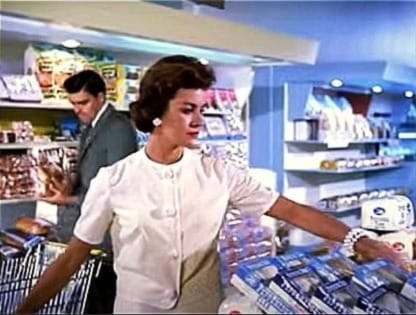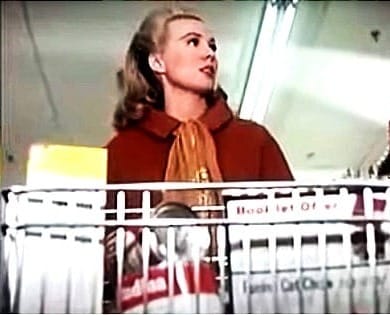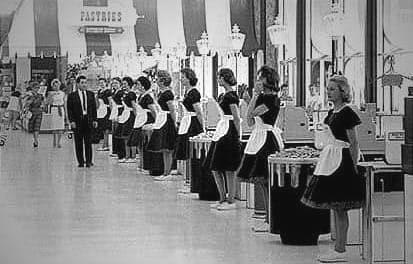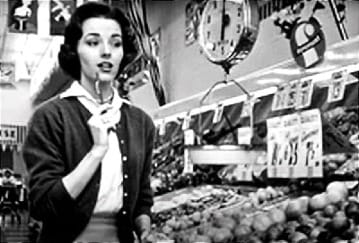Grocery Shopping at Midcentury: A Rising Standard of Elegance

Melons perilously stacked, vegetables beckoning alongside red packages of meat, abundance becomes tangible when exemplified by the grocery store. And the height of such pleasures is often linked to the postwar era, when convenience foods proliferated, and all seemed well with the American diet. More than anything, however, this period of consumerism spoke to prosperity, a rising standard of elegance for ordinary families.
True, markets are nothing new. But the advent of "supermarkets," with their well-stocked aisles and specialty departments, became the standard after World War II. As an age of prosperity unfolded, and homes equipped with appliances became the norm, American shopping kept pace, women donning their favorite outfits for the occasion. At midcentury, there was an aspect of glamor to food purchasing. Was the entertainment industry involved in creating this aura?

In order to encourage customers to use shopping carts--which had initially been resisted by the public--attractive actors were employed to assist. Once it became glamorous to push a metal cart on wheels, the practice became standard, and retailers could count on increased sales. By the 1950s, most shoppers filled carts to the brim with items they had not intended to purchase. But it was all part of the suburban experience to which a growing middle-class was becoming accustomed.

A full refrigerator was essential, not only for daily life, but for the occasions of leisure most families enjoyed. Inviting friends to your midcentury modern home called for an array of food items, including wines, decadent desserts, and an assortment of liqueurs. This was the new standard of entitlement, a true departure from the 1930s and those breadlines of the depression. For postwar shoppers, the supermarket was a place to model new clothes, while making tasteful purchases. But the reach of prosperity extended into the employment realm, beyond those legions of housewives pushing their carts.
Along with the wealth of items available to shoppers, there were supermarket jobs that promised upward mobility, enabling the purchase of homes and the enjoyment of security for numerous families. The years immediately following World War II were prosperous on many levels, the joys of which we can revisit in old photographs.

For my part, the golden age of supermarket shopping forms a collage, social history, economics, art, and architecture all being equally represented. Beyond this, the old images are entertaining and bright, thanks to the film colors of the 1950s, and imply the fulfillment of dreams, as middle-class comfort became available to more and more families. However, there was already a strong infrastructure in place for midcentury supermarkets, a standard by which to measure shopping and daily life. Let's visit the Piggly Wiggly.
Shopping Innovations from the South

In 1916, Clarence Saunders opened his first Piggly Wiggly in Memphis, Tennessee, promising that the new chain would enrich society with "more and cleaner things to eat." (1) In addition, he introduced the modern supermarket experience, with an abundance of products arranged for ease of selection, and larger aisles granting more personal space for comfort. However, his main contribution had to do with cost reduction. Doing away with delivery boys, and forcing customers to transport their own groceries, allowed Saunders to pass considerable savings along to shoppers. Aided by new technologies, the time is money business model was beginning to manifest.
Saunders created Piggly Wiggly during an era of inventions and rapid change in society. All of these shrank barriers in time and distance and introduced more convenience into everyone's life. He understood more clearly the changes brought to society by technology than many of his peers. (2)
Today, one can still visit a Piggly Wiggly to find discounted groceries, although the elegant glass fixtures disappeared long ago, and employees no longer resemble cheerful household servants. Times have changed. As for Saunders, we must remember that he paved the way for another innovation, a situation which remains prominent to this day, the rise of convenience foods--instant potatoes, anyone?
Canned Foods & Preservatives

Who could forget the delight of covering fried Spam with Bisquick?
With lower prices and a proliferation of goods, shoppers were primed for the "TV dinners" and processed foods that would eventually comprise the American diet. Along with burgers and fries--foods that grew in popularity from the age of diners and drive-ins--packaged meals offered a new way of eating. I remember when Bisquick became the main ingredient of our pancakes, although my mother thankfully avoided Spam. Today, we understand the dangers of chemical preservatives, but such things were considered miracles of science in previous decades, freeing the time of countless housewives. And food companies delighted in turning a profit from the assorted pig parts of Spam (sausage in a can) and the abnormally long shelf life of baked goods--brought to you by chemicals. Yes, as the 1960s progressed, supermarkets overflowed with processed foods, kitchens held an array of appliances, and the future looked very bright indeed. However, the truth would soon emerge.
Gleaming supermarket aisles eventually began to show their tarnish, as concerns over chemical preservatives grew and subdued the bliss of shoppers. More than this, however, supermarkets of our time have an added issue, as they often provide a backdrop for scenes of unrest.
Elegance in Decline

Walmart fights are now a staple of online entertainment and, no less, a sad commentary on the decline of civility. Although public fights happened in previous decades, the prevalence with which they now occur is quite disheartening. Gone are the pearls and lavish decors, the lucrative jobs, and the assurances of prosperity. Today's supermarket employees face a dreadful bit of decline, sometimes encountering violence from the public. Sadly, the fight pictured above is emblematic of the times on many levels. So, what can we anticipate for the future of grocery stores and the culture of shopping?
Jungle Jim's International Market
Although sometimes necessary, trips to Walmart have begun to feel increasingly bleak, their vast spaces resembling detention facilities, the presence of biochemically manipulated "foods" feeling a bit oppressive. However, the veneer of prosperity can still be found at Jungle Jim's International Market, a place where numerous varieties of aged cheese, beers from across the world, and movie memorabilia await customers. In addition, the carnivalesque aspects of shopping can be found here, as well, with all the theatrical displays and animatronic characters one could desire.
Founded in 1971 in Hamilton, Ohio, the market appears to have found its place in the retail landscape, balancing low prices with exotic goods and the right amount of entertainment, this, in a world of declining freedoms and economic peril. And here we find one of the enduring legacies of midcentury shopping; supermarkets still provide a venue for relaxation and entertainment, as the retailer coaxes you to fill that massive cart on wheels.
On the Performative Aspects of Shopping

As you have discovered, one of my current research interests involves the realm of consumer culture, specifically, the ways in which we define ourselves according to our purchases. Beyond this, I am studying the performance and entertainment roles played by retail establishments, public spaces which have an ancient history to their credit. Scholar Nebojša Tabacki has published insightful new research in this area. From him, we learn about department store architecture, a close relative to supermarkets in their prominence and scope of influence:
Once inside the department stores, the opulence and scale of the architectural space, with the 'grandness and finery of metal balustrading, elegant bridges and flying staircases', and the smell of perfume that filled the air seduced customers by appealing to all their senses . . . (3)
Allure and the power of performance inform shopping experience, from supermarkets to department stores. I'll include additional sources at the end of this piece, so you can delve into your own research.
In my opinion, the elegance of midcentury life was no more (or less) than ordinary existence, the way average people lived and conducted themselves in public spaces. Sadly, the standards are falling, day by day. However, we can learn much about the potential of retail spaces from scholars and, after that, entertain ourselves by shopping for cheese at Jungle Jim's.
Works Cited:
(1) Freeman, Mike. "Clarence Saunders: The Piggly Wiggly Man" (Tennessee Historical Quarterly, FALL 1992, Vol. 51, No. 3, pp. 161- 169 Published by: The Tennessee Historical Society).
(2) ibid.
(3) Tabacki, Nebojša. Consuming Scenography: The Shopping Mall as a Theatrical Experience (London: Methuen Drama, 2020) p. 19.
For Further Reading:
Deutsch, Tracey. Building a Housewife's Paradise: Gender, Politics, and American Grocery Stores in the Twentieth Century (Chapel Hill: University of North Carolina Press, 2010).
Nixon, Sean. Hard Sell: Advertising, Influence, and Transatlantic Relations, 1951-1969 (New York: Palgrave, 2017).
Warnes, Andrew. How the Shopping Cart Explains Global Consumerism (Oakland: University of California Press, 2018).
All historical images are published here under the Fair Use Clause of U.S. Copyright Law for educational purposes.